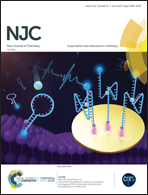Energy framework approach to the supramolecular reactions: interplay of the secondary bonding interaction in Ph2E2 (E = Se, Te)/p-I-C6F4-I co-crystals†
Abstract
In the co-crystals of diphenyl dichalcogenides Ph2E2 (E = Se, Te), the E–E and E–π(Ph) chalcogen bonds assemble Ph2E2 molecules into the chains, which imitate the typical packing patterns of the parent Ph2E2 crystals. These co-crystals consist of quite stable tectonic 1D and 2D Ph2E2 chain architectures, which are repeated in the crystals of pure Ph2E2 as well as in their co-crystals with the halogen bond donor molecules. These chains can be clearly visualized as separate parallel 1D and 2D structures in the energy framework diagrams in CrystalExplorer. From this point of view, the supramolecular reaction of Ph2E2 with the halogen bond donor 1,4-diiodotetrafluorobenzene (p-DITFB) can be considered as the insertion of p-DITFB molecules between the Ph2E2 chains in such a way that I–E and I–π(Ph) halogen bonds come in place of E–E and Te–π(Ph) chalcogen bonds, which are responsible for the close packing of these chains in the parent crystal form. Persistent packing patterns found in parent and binary crystals can provide insight into the mechanism of the crystallization process.

- This article is part of the themed collection: Selenium & Tellurium chemistry at the beginning of the 3rd millennium: a celebration of ICCST


 Please wait while we load your content...
Please wait while we load your content...